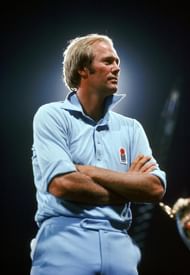Understanding the entertainment quotient of limited overs matches, Packer placed greater emphasis on them than had ever been given before in Australia.
Alongside the SuperTests, he organised the “International Cup”, a one-day series between the three participating teams. This was the first time cricket was played under lights at night, and it did garner some amount of attention, although it was nothing significant. Packer had one foot in the door, and little did the ACB know that he was going to force his way through.
The biggest problem for the ACB was the stand taken by the other ICC countries. Most of the English counties were more than happy to keep Packer’s boys on their rolls, and the severely cash-crunched West Indian board was only too happy to let their men play for Packer.
Similarly, South Africa was very keen to lets its cricketers play in the “Big League” and prove that they were among the best in the world, if not the best. The son of the head of New Zealand Cricket himself was turning out for WSC.
Pakistan adopted a hardline approach, but relented when Packer signed on more Pakistanis after the first season. India was away from the humdrum of it all – they had still not become a cricketing superpower, and although some of their players (Sunil Gavaskar and Bishan Singh Bedi) were greats in their own terms, they did not fit in with the razzmatazz of the WSC.
Packer spent the off-season planning tours to New Zealand and West Indies and recruiting more overseas players. At one point of time, rumours started doing the rounds that the next season could see full-fledged English and Pakistani teams as well.
Another masterstroke that worked for Packer was the borrowed “Cavaliers” concept. In the 1960s, an ad hoc team of famous cricketers, titled “The International Cavaliers”, started touring venues that rarely saw big games in order to promote the game.
Packer used the same idea to plan a tour which would cover the provincial centres from Queensland to Tasmania, and which would feature recently retired cricketers and bright upstarts playing regularly for and against each other.
So you had the likes of Eddie Barlow, Ian Redpath, David Holford and Rohan Kanhai playing with the likes of Trevor Chappell and Kepler Wessels, who would go on to play for Australia some years later. In this process, Packer signed up a number of young Australian cricketers, which made the ACB’s job even harder.
The last trick Packer pulled out of his multi-dimensional hat was exercising his political clout to overturn the WSC ban at the Sydney Cricket Ground and at the Gabba. Not only that, he also got the New South Wales government to reimburse the bill for the light towers installed for his use at the SCG!
Packer also got the clearance to go ahead and use the Adelaide Oval, but he refused. Perth and Adelaide were off the agenda for the second season – his new strategy now was to focus on the traditional homes of Australian cricket and extract his pound of flesh from the ACB the following season.
Follow IPL Auction 2025 Live Updates, News & Biddings at Sportskeeda. Get the fastest updates on Mega-Auction and cricket news

